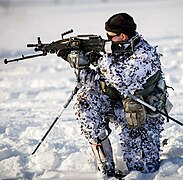Self-decoration camouflage

Self-decoration camouflage is a method of camouflage in which animals or soldiers select materials, sometimes living, from the environment and attach these to themselves for concealment.
The method was described in 1889 by
Among animals, self-decoration is found in
History

In 1889, William Bateson observed in detail the way that decorator crabs fix materials on their backs. He noted that "[t]he whole proceeding is most human and purposeful", and that if a Stenorhynchus crab is cleaned, it will "immediately begin to clothe itself again with the same care and precision as before".[1]
In his book The Colours of Animals (1890), Edward Bagnall Poulton[2] classified protective animal coloration into types such as warning colours and protective mimicry. He included self decoration under the heading "Adventitious Protection", quoting Bateson's account of decorator crabs.[3]
In his textbook
In animals

A variety of animals, both
Antipredator adaptations
Self-decoration is seen in some insects such as
Aggressive mimicry
Chrysopidae lacewing larvae decorate themselves with a mixture of materials including moulted cuticle and their own droppings, which appears to serve both to camouflage the larvae and to repel predators. Larvae of species that eat aphids decorate themselves with the waxy material produced by the aphids; larvae decorated like this are ignored by ants which farm the aphids, whereas the ants eject undecorated larvae, making this a wolf in sheep's clothing strategy of aggressive mimicry.[5][9] Some owlfly larvae, which are ambush predators, similarly self-decorate, hiding until prey comes within range.[10]
The strategy has been used by traditional human hunters, such as when
In military usage
Snipers, working alone, rely heavily on effective camouflage. This is often provided by a ghillie suit, a whole-body covering fitted with many loops into which the wearer can insert grass or other plant materials to match the local environment, or are made with cloth simulating tufts of leaves. Such good camouflage comes at the price of the weight of the ghillie suit and the attached materials; the suit is hot and uncomfortable to wear in hot weather, and it restricts mobility.[12]
The ghillie suit was developed by
Cott used the example of the larva of the
-
British and French snipers in ghillie suits
-
Swedish paratrooper on skis with a winter ghillie suit
References
- ^ S2CID 250948106.
- ^ Poulton, Edward Bagnall (1890). The Colours of Animals, their meaning and use, especially considered in the case of insects. London: Kegan Paul, Trench, Trübner. pp. 76–79.
- ISBN 9780300178968.
- ^ .
- ^ a b c d Bates, Mary. "Natural Bling: 6 Amazing Animals That Decorate Themselves". National Geographic. Archived from the original on June 11, 2015. Retrieved 11 June 2015.
- ISBN 978-0-521-19911-7.
- hdl:2246/5820.
- S2CID 7894145.
- S2CID 11558335.
- .
- ^ Ballou, Maturin M. (1889). Foot-Prints of Travel. Boston: Ginn & Company. p. 64.
- ^ ISBN 0-87364-704-1.
- ISBN 0-87364-704-1.



